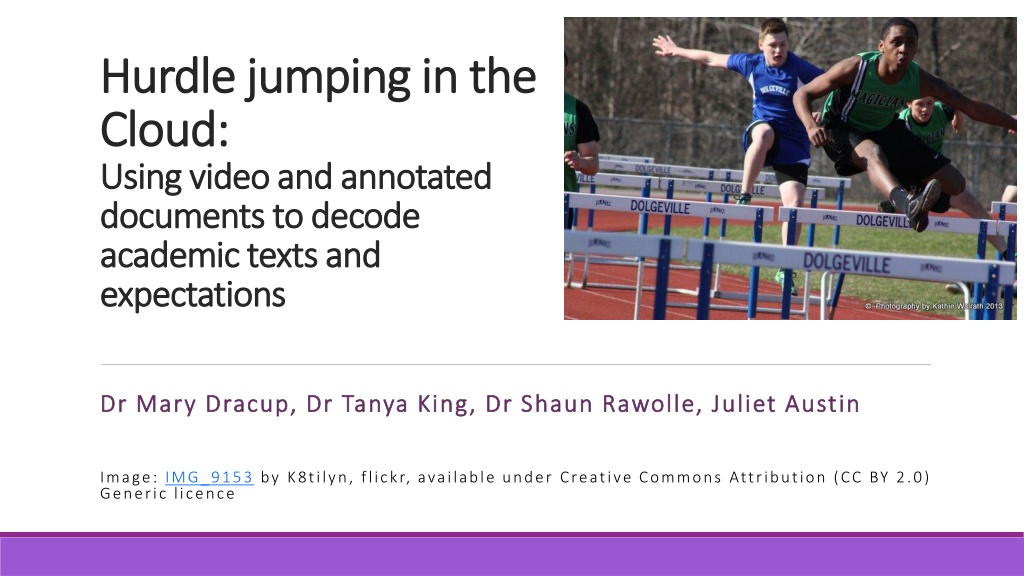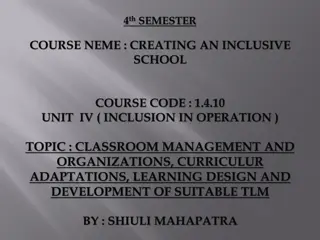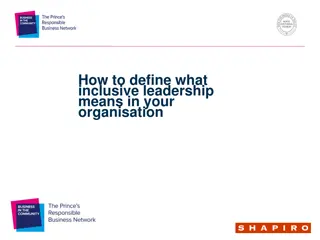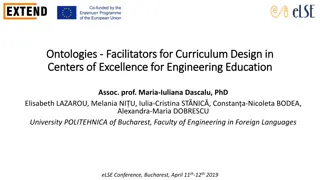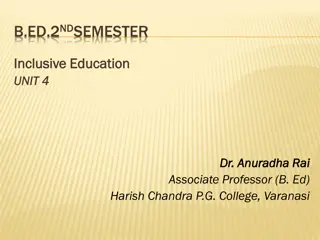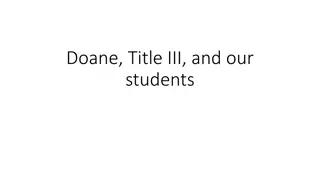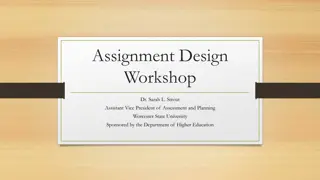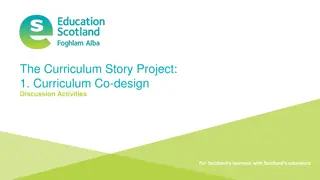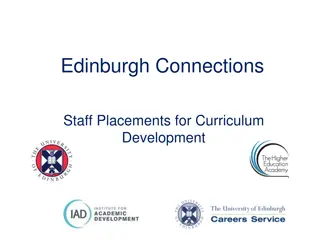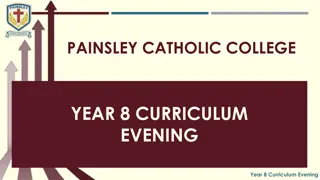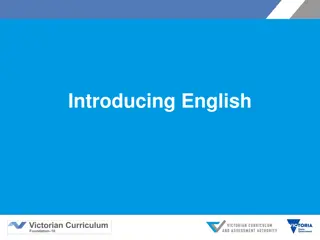Enhancing Academic Success Through Inclusive Curriculum Design
Incorporating inclusive curriculum design strategies can improve academic outcomes for diverse student populations. Driven by a need for equitable learning experiences, the approach considers students' backgrounds, experiences, and potential barriers to learning. By leveraging various tools such as videos, annotated documents, and tailored support, institutions can create a welcoming and supportive environment for all learners, leading to higher success rates and academic achievement.
Download Presentation

Please find below an Image/Link to download the presentation.
The content on the website is provided AS IS for your information and personal use only. It may not be sold, licensed, or shared on other websites without obtaining consent from the author. Download presentation by click this link. If you encounter any issues during the download, it is possible that the publisher has removed the file from their server.
E N D
Presentation Transcript
Hurdle jumping in the Hurdle jumping in the Cloud: Cloud: U Using video and annotated sing video and annotated documents documents to decode to decode academic texts academic texts and expectations expectations and Dr Mary Dracup, Dr Tanya King, Dr Shaun Rawolle, Juliet Austin Dr Mary Dracup, Dr Tanya King, Dr Shaun Rawolle, Juliet Austin Image: IMG_9153 by K8tilyn, flickr, available under Creative Commons Attribution (CC BY 2.0) Generic licence
No. of marks Median Mean All Deakin students T2 2015 33,736 66 59.5 Low SES students 3,958 65 58.1 Regional or remote students Non-English speaking background students Women in non-traditional areas 7,215 68 61.9 2,638 63 58.1 4,972 66 61.1 Students with disability Aboriginal and/or Torres Strait Islander students 1,999 65 57.8 346 56 42.9 Low ATAR students (<60) Deakin College pathway students 2,387 59 52.0 763 61 57.3 Cloud students 3,306 64 53.6 First in family students 13,820 66 59.9 Mature age students 9,002 67 58.5 International students 2,717 63 58.4
Inclusive curriculum An inclusive curriculum design approach is one that takes into account students educational, cultural and social background and experience as well as the presence of any physical or sensory impairment and their mental well-being. It enables higher education institutions to embed quality enhancement processes that ensure an anticipatory response to equality in learning and teaching. (Higher Education Academy UK 2011, Inclusive curriculum design in higher education, p. 3)
ASS234 (Environmental Anthropology) High proportion of students from varied academic backgrounds, first-in-family, low-SES Cloud students, from across disciplines Difficulties: Reading Anthropology readings Understanding expectations of Anthropology students Strategies: Explain Everything videos to highlight, explain expectations in unit guide Videos, annotated PDFs and Word docs of key readings Video of past Anthropology student s strategies for success Students create one-page visual fact sheets to lead weekly tutorials Dr Tanya King
Success rates (%) ASS234 2015 88.9% ASS234 2014 69.3% Faculty of Arts and Education 87.7% Deakin Overall 84.6% Unit cohort All unit attempts Unit campus Cloud (online) Geelong Waurn Ponds ATAR group Low ATAR (<60) Mid ATAR (60 - 80) High ATAR (>80) Equity groups Low SES students Other students Regional or remote students Other students Non-English speaking background students Other students Students with disability Other students Women in non-traditional areas Other students Aboriginal and/or Torres Strait Islander students Other students First in family students Other students 58.5% 85.7% 89.6% 87.8% 82.0% 89.2% 80.9% 84.9% 66.7% 63.2% 100.0% 85.7% 100.0% 100.0% 80.7% 90.8% 95.5% 79.6% 87.5% 94.2% 87.5% 67.5% 73.7% 66.0% 100.0% 86.1% 90.9% 87.8% 100.0% 88.7% 83.3% 89.5% 83.3% 89.5% 100.0% 88.7% 90.2% 87.7% 81.9% 88.4% 86.7% 87.9% 88.3% 87.6% 82.8% 88.0% 90.6% 87.5% 62.8% 87.9% 88.1% 87.4% 82.6% 84.9% 87.5% 83.9% 77.3% 85.7% 82.8% 84.7% 84.0% 84.7% 60.0% 84.8% 86.0% 83.7% 66.7% 69.6% 0.0% 70.9% 33.3% 72.0% 74.5% 63.4%
Student responses On annotated readings I found them really helpful, to focus on what she wanted us to focus on in the article, rather than me just hoping that I d got the gist of the idea kind of thing. So I found them really helpful (focus group) It seems so much more relevant when you re reading it on the pdf than if it s a separate study guide, and study guides have a tendency to get really loaded (focus group) I have greatly appreciated the annotations that you have included in this unit's readings. It has helped me to link the information together and at times when a paragraph is heavy with info, it has helped to break it down into digestible bits (survey)
Teacher responses On video commentary of unit guide I noticed a big drop-off in the thousand and one questions that you get at the start of the semester I ve already answered them it encouraged them to look closely at the unit guide, which they are supposed to do anyway, but it encouraged them to do that (interview) On the impact of the new resources and activities Certainly the quality of the presentations in class to me indicates that they ve understood the readings much more thoroughly, they ve really taken the time to pull out some of the key ideas and they ve done that consistently, so it s not just the brilliant students who ve done it and the rest have done OK, they ve all done a good job, I find that they re all getting very good marks, so that s a good thing. I feel like they are understanding the readings in much more depth, which means that we are able to all discuss them in a lot more detail (interview)
ETP102: Social contexts of education High proportion of students with varied academic backgrounds, first-in-family Large student numbers, across campuses Difficulties: Complex readings and concepts Multi-part assignments Strategies: Infographic of assignment requirements Videos on decoding policy texts, advice from a former student Annotated docs of key readings Librarian lecture spot and narrated PPT to help find resources for particular assignments Formative peer assessment activity Dr Shaun Rawolle
Preliminary conclusions Video and text-based annotations to key documents such as unit guide, key readings CAN help decode and demystify academic texts and explain expectations Provide transcripts or text equivalents, eg annotated PDFs and Word docs, to increase access Promote the resources in class, in news items Make them easy to find on CloudDeakin They MUST be timely for students Target efforts to most important documents, they can take time to create Division of Student Life can advise on reading strategies, key questions Library can help students find and evaluate good resources Teach Assist can advise on video making, Explain Everything, DeakinAir, etc.
